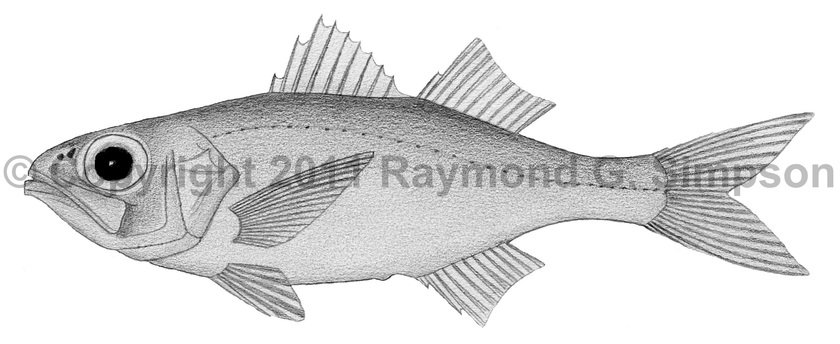
Common Name
Smallscale Lanternbelly
Year Described
Schultz, 1940
Identification
Dorsal Fin: IX-I, 9-10 (usually 10)
Anal Fin: II, 7-9 (usually 9)
Pectoral Fin: 15-16
Pelvic Fin: I, 5
Lateral Line Scales: 31-38
Gill Rakers: 23-26 total in first arch (16-18 in lower limb)
Vertebrae: 10+15 = 25
Body quite elongate with body depth 3.3-3.8 times in SL. Upper and lower jaws with canine teeth. Palatine teeth villiform. Preopercle with a few weak serrations. Lower rear margin of preopercle without ridges. Dorsal fins very close together or touching. Anterior margin of pelvic fin smooth. Anterior edge of second dorsal and anal fin spines smooth. Occiput naked. 21-28 pseudobranchial filaments.
Color
Dark above, grading to silvery below.
Size
Ranges from 53-145mm SL.
Habitat
Continental shelf from 180-576m.
Range
Florida to Colombia and the Caribbean islands to the Lesser Antilles.
References
Heemstra, P.C. 2002. Parazenidae (Pp. 1203-1204), Zeniontidae (Pp. 1205-1206), Zeidae (Pp. 1207-1209), Oreosomatidae (Pp. 1212-1213), Grammicolepidae (Pp. 1214-1216), Moronidae (Pp. 1294-1296), Acropomatidae (Pp. 1299-1303). In: Carpenter, 2002. The living marine resources of the Western Central Atlantic Vol. 2: Bony fishes part 1 (Acipenseridae to Grammatidae). FAO Species Identification Guides for Fisheries Purposes. American Society of Ichthyologists and Herpetologists Special Publication No. 5.
Mejía, L.S., A. Acero P., A. Roa and L. Saavedra. 2001. Review of the fishes of the genus Synagrops from the tropical Western Atlantic (Perciformes: Acropomatidae). Caribb. J. Sci. 37(3-4):202-209.
Schwarzhans, W.W. & A.M. Prokofiev. 2017. Reappraisal of Synagrops Günther, 1887 with rehabilitation and revision of Parascombrops Alcock, 1889 including description of seven new species and two new genera (Perciformes: Acropomatidae). Zootaxa 4260: 1-74.
Schwarzhans, W. W., Mincarone, M. M., & Villarins, B. T. 2020. A new species of the genus Verilus(Teleostei, Percomorpha, Acropomatidae) from Brazil. Zootaxa, 4751(3), zootaxa-4751.
Other Notes
The only other Verilus that has 9 anal fin rays is V. costai from Brazil. It differs in gill raker count, size, body morphometrics, and range.